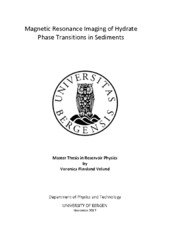| dc.description.abstract | Natural gas hydrates, simplified described as gas compressed in ice, are a substance existing in large quantities around the world. Their existence requires elevated pressures and low temperature. They are therefore found in the subsurface in and below permafrost and in oceanic environments below a water column of 400-500 meters. The significant amount of gas stored in natural gas hydrates constitutes a potential as a significant contributor in ensuring future energy sustainability. However, extended research on fundamentals and characteristics of hydrates in nature, as well as production schemes, are required to be able to efficient and safely exploit this energy resource. Core-scale experiments give fast and valuable information, which is essential before larger field tests can be planned. This thesis is part of a research collaboration between Statoil and the University of Bergen in the application of magnetic resonance imaging (MRI) in laboratory petro-physics and core analysis. The new experimental design in this work includes the high field strength magnet of the 4.7 Tesla Biospec MR-scanner, by contrast to the domination of low field strengths in this kind of research. The main objective of this thesis is to show that the high field strength MRI can be applied to visualize gas hydrate phase transitions in a porous media of a sandstone core, before more advanced studies can take place. First, basic introductory experiments were conducted to illustrate the correlation of water saturation of a core and the signal intensity of the MRI measurement. Two Bentheim sandstones were measured, one with increasing water saturation for each measurement, and the other with decreasing water saturation for each measurement. Two types of MR measurements were conducted on the cores at each water saturation stage: (1) RARE, used to image and for further pixel analysis, (2) MSME, to investigate T2 relaxation. Results from the introductory experiments illustrated the strong relationship between MR signal intensity and water saturation. This fact was fundamental in analyzing the results of the high-pressure study. Second, MRI measurements of gas hydrate formation and dissociation within sediments were acquired. The Bentheimer sandstone was initially saturated with 65% with 0.1wt% sodium chloride (NaCl). The gas consisted of 22% propane in 78% methane. This gas mixture was chosen to provide hydrate stable conditions at room temperature (21°C). Stimulation of gas hydrate formation and dissociation were therefore possible by regulating the gas pressure when the core was mounted in a high-pressure cell. Two types of MR measurements were conducted through the hydrate study: (1) RARE, used to image and analyze the spatial development in the core, and (2) CPMG to investigate how T2 relaxation changed with hydrate formation/dissociation. Phase transitions of gas hydrate in the Bentheimer sandstone were successfully imaged and visualized by both RARE and CPMG measurements. Three different methods are suggested for estimation of hydrate saturation. The methods are based on results from (1) pixel analysis by RARE, (2) T2 distribution maps by CPMG, and (3) the initial signal intensity of the decay curve by CPMG. Estimations from the three different methods were in good agreement, and found hydrate saturation to be in the region of 42±3 %. Because of the good agreement, saturation estimations based on measurements attained from a high field strength magnet were found to be promising. | en_US |
